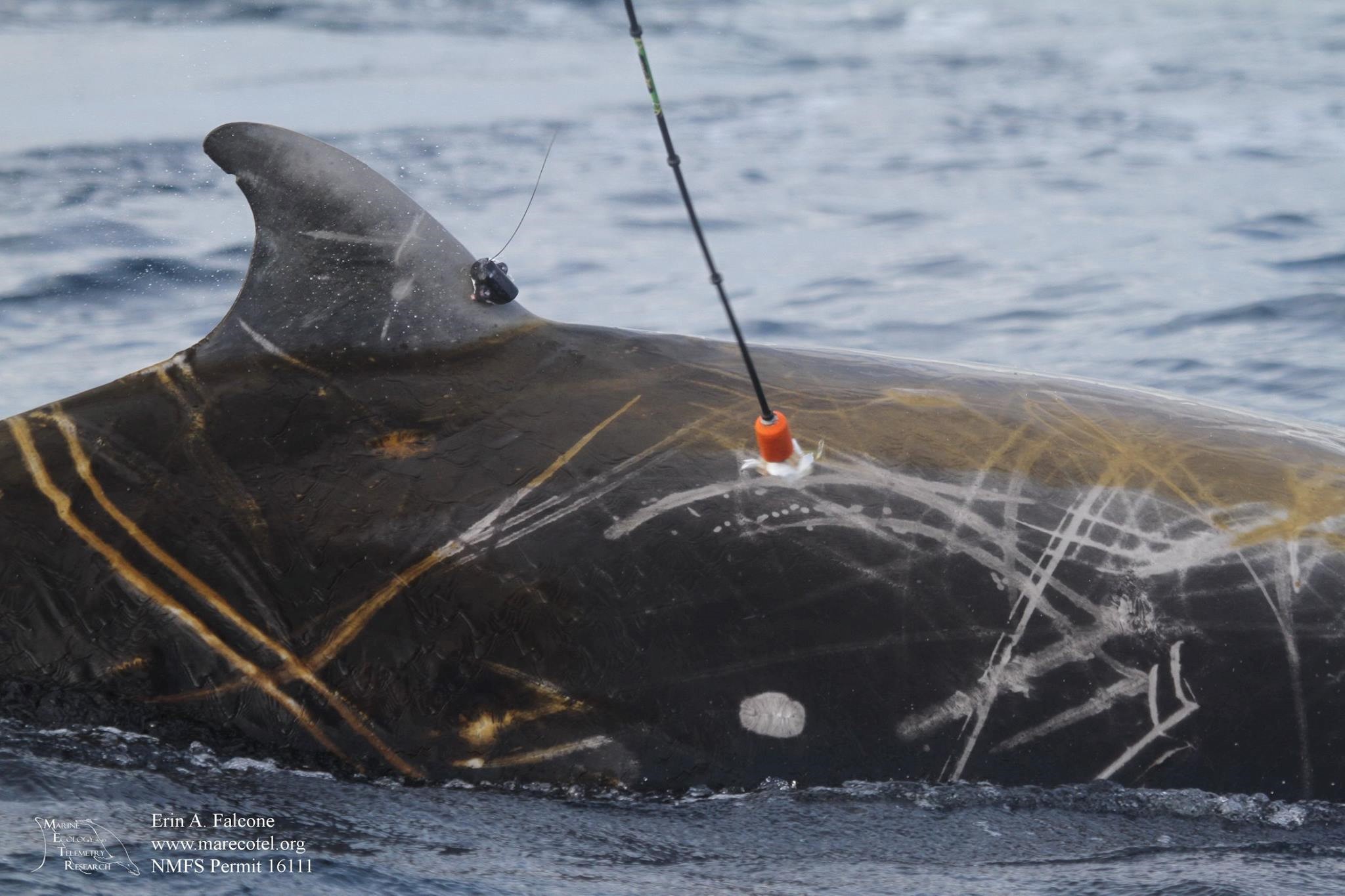01 Mar Newsletter March 2018
Welcome to the Wildlife Computers Newsletter
This newsletter will be available quarterly and cover topics like recent news, tips and tricks on working with our tags, interpreting data, and a look at some of the fascinating research taking place in our world.

MarEcoTel Introduces New Study

In August, Marine Ecology and Telemetry Research published results from a recent study which focused on how Cuvier’s beaked whales reacted to military sonar. Researchers concentrated their efforts off the coast of Southern California—an area frequented by the US Navy. The whales were tagged with Wildlife Computers SPLASH10 LIMPET satellite tags.

A SPLASH10 LIMPET tag is deployed on the dorsal fin of an adult male Cuvier’s beaked whale. The tag had just been deployed as this photograph was taken, and can be seen on the leading edge of the dorsal fin. The deployment arrow, including the orange-colored float, has detached from the tag and is bouncing clear of the whale for recovery by the tagging vessel.
The tags transmitted diving behavior including “start and end times, maximum depth reached, total duration and an approximate dive shape.” Data were recovered using Argos satellites and a Wildlife Computers Mote—“which significantly improved behavior log data throughput.” Researchers saw many changes in behavior when sonar was used near the animals (100 km and closer) including longer dive times, which was especially pronounced in the presence of helicopter-deployed sonar.
The Future of Onboard Processing
Recently, you may have noticed people using “Wildlife Computers SCOUT-DSA” tags (Cox et al. 2017), or other instruments with the SCOUT name. Currently, SCOUT tags are in the research phase, but we wanted to explain in further detail what these tags do. SCOUT tags are Wildlife Computers tags capable of a new level of onboard data processing. For some species and research questions, two-dimensional horizontal and vertical movement (via histograms or behavior logs) just isn’t cutting it anymore. Researchers can dig deeper into animal movement and behavior by using accelerometers and other inertial motion sensors. However, the physical amount of data produced by the high-rate sampling of these sensors makes data archiving and instrument recovery a necessity. There is simply too much data to transmit via satellite. Consequently, not everyone can take advantage of these types of data because they are not able to recover their instruments. This is where more sophisticated onboard processing comes into play. SCOUT tags are different from our other instruments in that they can provide data products previously available only with instrument recovery and post-processing of the archived data. SCOUT tags implement algorithms in their onboard processing to create data products that are compact enough to be transmitted via satellite.
We have several data products that we are currently developing and testing with different species. Data products from two versions of “Activity per Dive Segment” algorithms transmit either the number of “active events” or “prey capture attempts” per dive segment for marine mammals and other air-breathing animals. In addition to activity data, we have also implemented algorithms to create oceanographic data products. These were developed so that sharks and other animals can collect GPS-stamped oceanographic profiles while moving throughout their habitat. These profiles are designed to be ingested by climate and weather databases.

Showing two sperm whale dives. The data records on top look at archived depth and accelerometer data with prey capture attempts identified using the acoustic record of buzzes from whales.
All of these data products are part of an on-going effort we hope to adapt, test, and validate on multiple species over the next two years. The activity algorithms were tested on Elephant seals and Sperm whales. We are in the middle of the validation process for sharks and large fish and have a plan in place to validate on Grey seals this summer. My goal over the next few years is to collaborate with other researchers to validate onboard processing algorithms on multiple species including Harbor seals, Hawaiian monk seals, California and Steller sea lions, Northern fur seals, as well as other species of sharks and fishes. If you are interested in being a part of this adventure, or if you have suggestions about the inclusion of other species, please contact me. Our overarching goal is to make this a collaborative process and develop one or more data products to enable more researchers to take advantage of high-rate accelerometer data.
Dr. Kenady Wilson is Wildlife Computers resident biologist and data whisperer whose research focuses on quantitative applications for telemetry data. Dr. Wilson is the developer of new analysis methods for telemetry data and author of several research publications including her latest Estimating animal utilization densities using continuous-time Markov chain models. Her publications include work with Stellar sea lions, Harbor seals, and Hawaiian monk seals. She holds her Ph.D. from Duke University. She likes being outside with friends and family and hates it when people put nuts in baked goods.
Research
Product Research Survey
The only way to understand how you use Wildlife Computers technology is to ask! Take our quick, five-minute survey to give us feedback.
Recent Research
Our customers do amazing things including research on incredible animals using our tags. We’ve gathered all the recent research utilizing Wildlife Computers technology.
What’s New from Wildlife Computers
Payload Recovery Device
Animal and telemetry data are priceless but recovering that data can be challenging. The Payload Recovery Device is the best way to recover your data with minimal effort and disturbance to the animal. Designed for pinnipeds, the Payload Recovery Device can survive onshore abuse and depths up to 2,000 meters. There are many ways to find the device including Argos locations, a strobe light, or a UHF beacon. The Payload Recovery Device can be used multiple times so the same valuable payload can be used again right away. The Payload Recovery Device is the only commercially available release system suitable for deployments on seals, sea lions, and fur seals. As a bonus, there are no shipping restrictions with the Payload Recovery Device unlike other squib-style release mechanisms.
New Tags for Birds
The Rainier-S20 is a solar-powered, GPS-equipped Argos transmitter (PTT) tag specifically designed for birds. The Rainier-S20 has a very low profile and sports a powerful and flexible antenna, smooth surfaces, and rounded edges with no sharp/cutting finishes. The design helps minimize mass, drag, and risk of injury to the bird.

Tips from the Experts
Ever wondered how to safely connect to a recovered tag to get your data? Our experts outline an easy step-by-step approach.
![]()
Upcoming Events
We are on the road throughout the year. Stop by to see what’s new.
If you don’t see us on the road, connect with us online!




